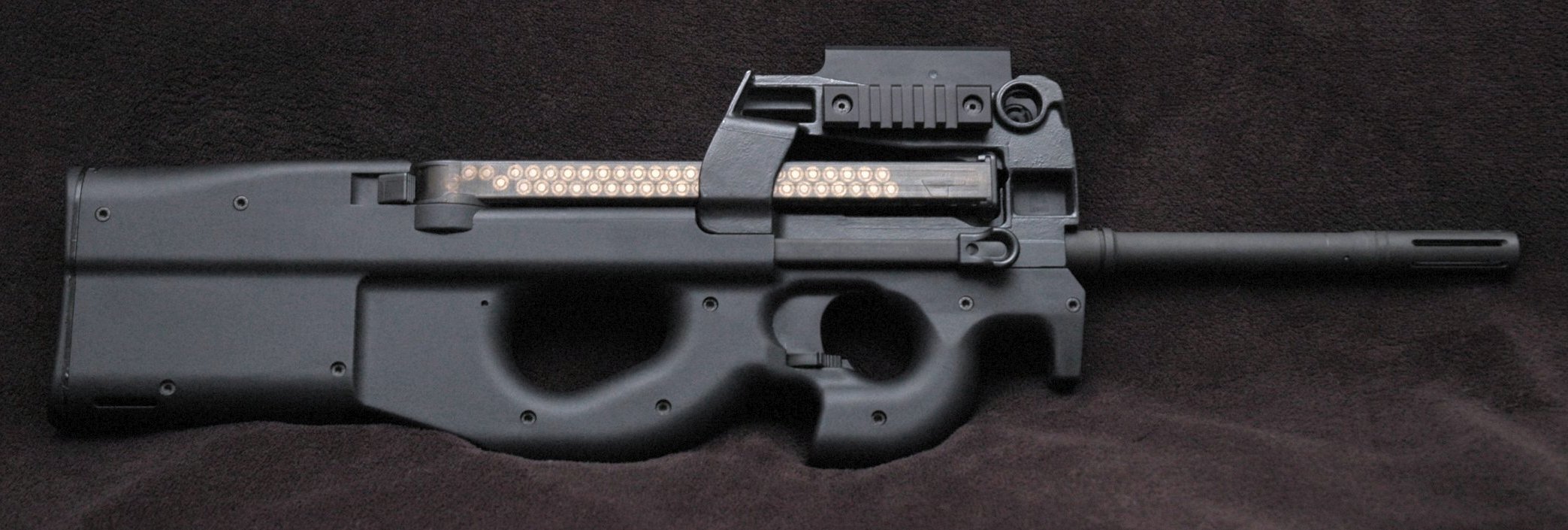This is a continuation of last week’s blog post stolen from the parallel reality in which bullpup long guns became mainstream decades ago and are now considered the default. AR-15? Who’s heard of that thing? Everyone has a Steyr AUG or a K&M M17S these days. If you haven’t already, go read last week’s post for more explanation. Note: This is (still) a joke. I am not aware of the existence of any actual parallel universes, even the one where Bush Sr. never signed the 1989 import ban.
Bullpup Ergonomics
Hello and welcome to another post on the San Diego County Gun Owners blog. In last week’s blog post, I gave one reason why bullpup rifles and shotguns displaced their conventional counterparts to become dominant among military, law enforcement, and civilian users alike. Placing the breech behind the firing grip instead of in front of it saves a tremendous amount of overall length, which is why the bullpup concept exists in the first place, but compactness is far from its only advantage.
A secondary but significant factor contributing to the overwhelmingly greater popularity of bullpup platforms such as the Steyr AUG, Bushmaster/K&M M17S, and IWI Tavor over their conventional counterparts such as the AK, AR-10/AR-15, FN SCAR, and HK416 is ergonomics.
Control Layout
Although the idea of deleting the shoulder stock from a rifle (or shotgun) and moving the grip and trigger forward to compensate dates back to the early part of the last century, most of long guns that are popular today were developed in the 1970s or later. Compare this to the most widespread conventional guns: most hunting-style rifles and shotguns are functionally identical or similar to ones from a hundred years ago, and most semi-auto centerfire rifles, such as the AK and AR platforms, are based on designs from the ‘50s or earlier. The bullpups we have today simply had more “time in the oven” for their engineering teams to figure out control layouts that make logical sense.
Ambidextrous Operation
One obvious disadvantage of conventional long guns is their lack of ambidexterity. Although no limitation inherent to the breech-in-front-of-grip layout precludes such functionality, and indeed there have been some recent developments in conventional platforms to address this shortfall, relatively few conventional rifles allow for fully ambidextrous operation.
By contrast, of the eight or so factory bullpup semi-automatic centerfire rifles on the U.S. civilian market—the K&M (formerly Bushmaster) M17S, Steyr AUG, Springfield Hellion (HS Produkt VHS-2), IWI Tavor family, Desert Tech MDR, FN PS90, and Kel-Tech RDB and RFB—all seven feature user-reversible or fully ambidextrous controls. The latter six also have reversible, forward, or downward ejection systems. The story is similar for military rifles: the VHS-2, AUG, Tavor, and FN F2000 and P90 are designed to work for both left- and right-handed shooters; the only bullpup service rifle currently in standard issue that lacks provision for left-handed use is the UK’s own L85A2.
Within the realm of shotguns, all three major civilian offerings—the famous Kel-Tec KSG, IWI TS12, and Smith & Wesson M&P 12—feature ambidextrous controls. True, some of the no-name imported models are have problems in this regard, but then again, cheap conventional shotguns are notoriously fragile and unreliable, so I don’t think it’s fair to use low-quality firearms from no-name brands as representative examples in this discussion.
Comparison: Loading and Readying
In case you’re one of the few bullpup haters out there who’s still stuck pretending 60-plus-year-old long guns have modern features and functionality, compare and contrast the design and layout of the controls involved in the most common manipulations of popular bullpup and conventional firearms.
The process to load any of the common bullpup rifles and pistol-caliber carbines is the same. Simply insert the magazine, then rack the side-mounted charging handle present on all modern offerings other than the Hellion, whose top-mounted charging handle flips to either side so it handles like a side charging handle anyway. The only modern bullpup rifles of which I am aware which can only be charged from one side are conversions of older conventional rifles whose charging handles are integral with their bolt carriers. With a round now chambered, disengage the ambidextrous safety. This entire process can be completed with the rifle pointed downrange and the firing hand on the grip.
Many of the extant conventional rifles have different loading procedures. Most shooters will find it awkward and uncomfortable to insert the magazine forward of the pistol grip instead of behind it, but I’m sure this could be accomplished smoothly with enough practice. The FN SCAR, CZ Bren family, and Remington/Bushmaster ACR (may it rest in peace) have reversible side-mounted charging handles like we’re used to, though if you’re moving over from a Tavor, AUG, M17S, or Hellion, you may find the conventional rifles’ charging handles uncomfortable; located as far forward as they are, they offer less leverage and are therefore objectively more difficult to use. With a round now in the chamber, disengage the safety. You won’t find many AUG-style crossbolt or PS90-style disc safeties on “conventional” semi-automatic rifles; most have rotary thumb levers, though some (I’m looking at you, AR platform) are only located on the left side.
The story for the AR-10/AR-15 and HK417/HK416 platforms gets even worse. They use a “T”-shaped charging handle located at the rear of the receiver, forcing the shooter to take his or her face off the gun to even use it, kind of like on an old-school Bushmaster M17S before K&M upgraded the platform. Worse still, the “T” handle isn’t even reversible, so left-handed shooters must either use an even more awkward technique or buy an aftermarket ambidextrous charging handle. Make sure you put that in your shopping cart alongside the aftermarket ambidextrous safety and ambidextrous magazine release, because those controls will need retrofitting, too. After about $100 or more in replacement parts, you’ll finally be able to give an AR-15 the functionality virtually every civilian bullpup equivalent already has out of the box. It still won’t have reversible ejection, though, so if you want to be able to shoot a retro AR left-handed without the cases ejecting directly backward into your face, you’re pretty much out of luck.
As if the AR’s “T” handle isn’t already bad enough, the AK platform’s charging handle is somehow even more awkward to use. The rifle’s disastrously bad control layout is a holdover from 1940s Soviet army doctrine which taught riflemen to do all their manipulations with the firing hand, completely backwards from what is now known to be optimal. After poking the toe of the magazine into the receiver and rocking it back to lock it in place, a right-handed shooter must either rotate the rifle about ninety degrees counterclockwise to access the charging handle, reach over the optics stack (if present) to grasp the charging handle from above, or contort the support arm to reach under the gap between the pistol grip and the magazine to get at the charging handle from below. Oh, and by the way, AK bolts don’t lock back while reloading, so you’ll have to do the charging handle dance every time you empty a mag. The safety isn’t accessible from a firing grip either; I shouldn’t have to tell you how huge a problem that is.
To load any of the “big three” shotguns (KSG, M&P 12, TS12), simply push loose shells into any open magazine tube; the openings are easily visible on the TS12 without even having to rotate the shotgun. The process is thankfully very similar for most “conventional” shotguns, though they generally only hold half as many shells. Unfortunately, only the Mossberg 500 family has what I would call a fully ambidextrous safety; the Mossberg Maverick 88, Remington 870, and even my beloved Winchesters all have crossbolt safeties embedded in the front of their trigger guards. A right-handed shooter can disengage these safeties with the trigger finger but must break a firing grip to engage the safety.
Conclusion
Now, I don’t mean to beat a dead horse without cause. It’s fine to have a weird gun you like anyway, even if it has a bizarre rear-mounted charging handle and wastes space by not housing its receiver inside its stock like a normal gun. The truth is, though, that guns set up that way don’t have innate advantages sufficient to outweigh the problems inherent to that awkward and inefficient layout.
This blog post has already gone on long enough, and I haven’t even covered everything I need to, so I’ll cut it off here for your sake. In my previous blog post, I showed that the bullpup configuration has a distinct size advantage over the old-school “conventional” layout, but it should be clear after this installment that compactness is far from the only advantage bullpup long guns have. With far superior control layouts and fully ambidextrous or user-reversible controls on all mainstream bullpup shotguns, rifles, and pistol-caliber carbines, it’s obvious why they became ubiquitous and “conventional” long guns like ARs and AKs faded into relative obscurity. Make sure you check back for the next part, in which I’ll put another nail in the coffin by discussing the weight and balance difference between the two configurations.





Comments